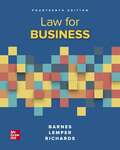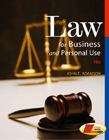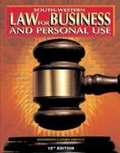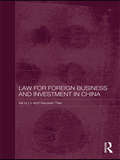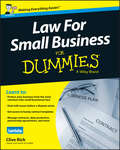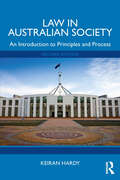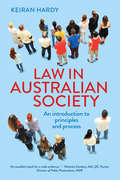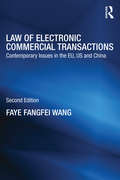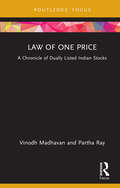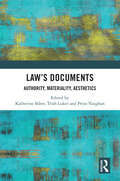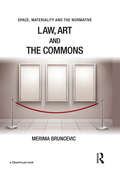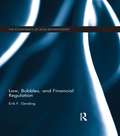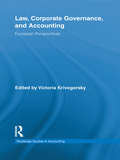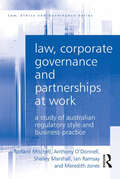- Table View
- List View
Law for Business
by Eric L. Richards A. James Barnes Timothy A. LemperA focus on readability and proven pedagogical devices ensures Law for Business is a student-friendly perspective that will aid students in their comprehension and critical analysis of often complex topics in business law. It’s comprehensive, yet concise approach is appealing to both students and instructors alike giving instructors flexibility and students the ability to understand the fundamental importance of how legal issues impact decision making in business.
Law for Business
by John E. Adamson Edward J. Conry Norbert J. MietusThis text effectively teaches an understanding of legal obligations and rights in business, and how to avoid legal difficulties. Law For Business effectively covers areas such as computer law, financial crimes, legal careers, environmental law, international law, and more.
Law for Business and Personal Use
by John E. Adamson Amanda MorrisonLAW FOR BUSINES AND PERSONAL USE, 19E provides instruction on the foundations of business law as well as the application of legal concepts to everyday life.
Law for Business and Personal Use
by John E. AdamsonAdamson (business, Southwest Missouri State University) outlines the U. S. legal system and explains how various laws apply to the rights and duties of small businesses. The 32 chapters discuss civil procedure, contract law, leasing of real property, wills and trusts, employment law, legal forms of business organization, and financial transactions. Annotation ©2006 Book News, Inc. , Portland, OR (booknews. com)
Law for Business and Personal Use
by John E. Adamson Norbert J. MietusThis 15th edition of Law for Business and Personal Use maintains a fundamental emphasis on business law, while introducing personal law topics that interest students. Give your students the most comprehensive coverage of contracts, ethics, employment law, credit, banking, partnerships, bankruptcy, etc.
Law for Business and Personal Use
by John E. AdamsonAdamson (business, Southwest Missouri State University) outlines the U. S. legal system and explains how various laws apply to the rights and duties of small businesses. The 32 chapters discuss civil procedure, contract law, leasing of real property, wills and trusts, employment law, legal forms of business organization, and financial transactions. Annotation ©2006 Book News, Inc. , Portland, OR (booknews. com)
Law for Business and Personal Use (16th edition)
by John E. AdamsonAdamson (business, Southwest Missouri State University) outlines the U. S. legal system and explains how various laws apply to the rights and duties of small businesses. The 32 chapters discuss civil procedure, contract law, leasing of real property, wills and trusts, employment law, legal forms of business organization, and financial transactions.
Law for Entrepreneurs
by Jethro K. Lieberman Don Mayer Daniel M. Warner George J. SiedelMayer, Warner, Siedel and Lieberman's Law for Entrepreneurs is an up-to-date textbook that covers the broad spectrum of legal issues that entrepreneurs must understand when starting and running a business. The text is organized to permit instructors to tailor the materials to their particular approach. The authors take special care to engage students by relating law to everyday events with their clear, concise and readable style. After introductory chapters covering the legal environment of business, Law for Entrepreneurs provides students with context and essential legal concepts relating to contracts, product liability, intellectual property, insurance, agency law, partnerships, corporations, and employment law. The text provides the vocabulary and legal savvy that entrepreneurs need to talk in an educated way to customers, suppliers, employees, creditors, shareholders, government regulators and other stakeholders — and to their own lawyers. With Law for Entrepreneurs, the authors have created a text that not only has both case summaries and excerpted cases, but one that you can easily customize by deleting chapters, reordering the content, adding your own material, and even editing at the line level with Flat World's easy-to-use MIYO (Make It Your Own) Platform. The free online version of the text includes embedded links to law-related videos at YouTube and other online sites for easy access by students and instructors.
Law for Foreign Business and Investment in China
by Xiaowen Tian Vai Io LoIn trying to establish a presence in China, foreign investors have found it imperative to understand the regulatory environment of this potentially huge market. This book provides an up-to-date overview of the legal framework for doing business in China. It covers such topics as state structure; legislative amendments and enactments on direct foreign investment; the court system; the legal profession; business entities; foreign investment enterprises; contracts; intellectual property; labor and employment; consumer protection; taxation; securities; and dispute resolution. Apart from explaining legal principles, the book highlights liberalisation measures that China has undertaken to fulfil its WTO commitments; elucidates complicated legal concepts with examples of court decisions; discusses relevant foreign trade and investment polices; and includes a glossary of Chinese terms.
Law for Project Managers
by David WrightLaw for Project Managers provides an easily understandable and practical guide to the laws of contract, liability, intellectual property and so on, entirely from the perspective of the project manager. It will enable you to approach projects forewarned and forearmed, able to avoid potential legal problems altogether. The book covers everything from intellectual property disputes with the client organisation about who actually 'owns' the outcome, to confusion arising during an international project from the different legal systems and their approach to contracts and health and safety problems in the management of contractors. Most importantly, it explains everything in very straightforward terms; legal jargon is either avoided altogether or defined with its relevance to the project manager explained. In essence, Law for Project Managers is a clear, readable and expert guide on this and many other important legal matters for the practising project manager as well as a supplementary text for post- or undergraduate students studying the commercial aspects of law, contracting and project management.
Law for Small Business For Dummies - UK
by Clive RichYour own in-house legal advisor—at a fraction of the cost Written in plain-English for business people without any legal training, Law For Small Business For Dummies covers everything you need to be aware of regarding the law when you're starting and running your own business. Cutting through the jargon that can make even the pros scratch their heads, this book quickly gets you up-to-speed on the key areas of business law, including contracts, websites, intellectual property, data protection and partnership agreements. Plus, you'll find out how small business law applies to advertising and marketing, confidentiality agreements, the sale and supply of goods (including e-commerce), negligence and product liability. There were 526,000 new businesses registered in the UK in 2013—and, at some point, all of them will be faced with legal risks that could make the difference between success and failure. One claim could wipe out a fledgling business' profits, and hit even big businesses harder than they could ever imagine. If you're the owner of a new business and need to get a handle on the ins and outs of small business law—and don't have the budget to employ an in-house legal advisor—this trusted, approachable guide is your answer. Covers the laws surrounding the most common risks small businesses face Addresses how to deal with legal issues before a potentially costly dispute arises Provides access to handy sample contract templates on Dummies.com Serves as your own in-house legal advisor—at a fraction of the cost If you're an existing business owner or an aspiring entrepreneur thinking about starting your own business, Law For Small Business For Dummies gives you answers to questions you didn't even know to ask!
Law in Australian Society: An Introduction to Principles and Process
by Keiran HardyWhat is the ‘rule of law'? How do laws get made? Does our legal and political system achieve justice for all Australians equally? Designed for beginners as well as non-law students, this textbook provides a comprehensive and accessible guide to understanding Australia's system of law and government.Law in Australian Society explains legislation and case law, courts, and the doctrine of precedent. Keiran Hardy examines the roles played by parliaments, politics, and the media. He explains founding principles, including democracy, liberalism, the separation of powers, and federalism. Human rights and justice are highlighted, with an emphasis on First Nations Peoples and the law. The book explains criminal responsibility and the justice system, including police powers and the criminal trial. It concludes with case studies of cybercrime and counterterrorism laws to illustrate law reform in action. This second edition has been fully updated throughout, including recent legislation, cases, and topical issues from Australian law and politics, including from the COVID-19 pandemic and the recent referendum on an Indigenous Voice to Parliament. Each chapter features practical examples, chapter summaries and review questions together with a glossary of key terms. Concise, accessible and up-to-the-minute, this is a vital guide for anyone seeking to understand Australian law and government.
Law in Australian Society: An introduction to principles and process
by Keiran HardyWhat is 'the rule of law'? How do laws get made? Does our legal and political system achieve justice for all Australians equally?Designed for beginners as well as non-law students this text provides a comprehensive and accessible guide to understanding Australia's system of law and government. Dr Keiran Hardy describes how legislation is made, the nature of case law, the hierarchy of courts and the doctrine of precedent. He looks at the role played by politics and the media in shaping law, and he describes founding principles including democracy, liberalism, the separation of powers and federalism. The criminal justice system is explained including criminal offences, police powers, sentencing and punishment, and there is a special emphasis on Indigenous peoples and the law. The book concludes with case studies of cybercrime and counterterrorism legislation to illustrate law reform in action. Each chapter features practical examples, chapter summaries and review questions together with a glossary of key terms.Concise, accessible and up-to-the-minute, this is a vital guide for anyone seeking to understand the complexity of Australian law and government.'This is an excellent book for a wide audience . . . equally useful for law students, legal studies students in high school and anyone seeking an understanding of how and why the law is as it is. And how things might be improved.' - Nicholas Cowdery, AM, QC, former Director of Public Prosecutions, NSW'A wonderful text . . . The overall structure and the inclusion of comprehension questions, glossaries and a curated reference list ensure that students can build on their understanding over the course of the book.' - Jackie Charles, Rule of Law Institute of Australia'This introduction to Australian law is comprehensive, contemporary and accessible. It is a perfect primer for new students requiring a broad understanding of Australia's legal system. From cybercrime to the workings of Australia's parliament, this book has it all.' - George Williams, AO, Dean, Anthony Mason Professor, Scientia Professor, University of New South Wales'Law in Australian Society' is an ideal text for first year students in criminology, legal studies, policing and related fields. Its easy-to-read format aids students in understanding the complexities and subtleties of the Australian legal system.' - Emma Colvin, Centre for Law and Justice, Charles Sturt University
Law of Commercial Transactions
by Jethro K. Lieberman Don Mayer Daniel M. Warner George J. SiedelMayer, Warner, Siedel and Lieberman's Law of Commercial Transactions is an up-to-date textbook that covers legal issues that students who engage in commercial transactions must understand. The text is organized to permit instructors to tailor the materials to their particular approach. The authors take special care to engage students by relating law to everyday events with their clear, concise and readable style.
Law of Electronic Commercial Transactions: Contemporary Issues in the EU, US and China (Routledge Research in Information Technology and E-Commerce Law)
by Faye Fangfei WangThe development of new technologies places new challenges to the interpretation and implementation of legislation in the information society. The recent deployment of service-oriented computing and cloud computing for online commercial activities has urged countries to amend existing legislation and launch new regulations. With the exponential growth of international electronic commercial transactions, a consistent global standard of regulating the legal effects of electronic communications, the protection of data privacy security and the effectiveness of Internet-related dispute resolution are motivating factors to build users’ trust and confidence in conducting cross-border business and their sharing information online. The second edition of this book continues taking a ‘solutions to obstacles’ approach and analyses the main legal obstacles to the establishment of trust and confidence in undertaking business online. In comparing the legislative frameworks of e-commerce in the EU, US, China and International Organisations, the book sets out solutions to modernise and harmonise laws at the national, regional and international levels in response to current technological developments. It specifically provides information on the key legal challenges caused by the increasing popularity of service-oriented computing and cloud computing as well as the growing number of cross-border transactions and its relation to data privacy protection, Internet jurisdiction, choice of law and online dispute resolution. It considers how greater legal certainty can be achieved in cloud computing service contracts and other agreements resulted in service-oriented computing. The second edition of Law of Electronic Commercial Transactions is a clear and up to date account of a fast-moving area of study. It will be of great value to legislators, politicians, practitioners, scholars, businesses, individuals, postgraduate and undergraduate students. It provides in-depth research into finding solutions to remove eight generic legal obstacles in electronic commercial transactions and offers insights into policy making, law reforms, regulatory developments and self-protection awareness.
Law of One Price: A Chronicle of Dually Listed Indian Stocks (Routledge Focus on Management and Society)
by Partha Ray Vinodh MadhavanLaw of one price continues to be a central tenet of Financial Economics. This book is devoted towards examining law of one price in the context of dually-listed shares of Indian companies. Put simply, this book delves on the relationship between the prices of domestic shares issued by Indian companies and the prices of foreign shares issued by the same companies. It also examines the evolving uncertainty in relationships between such dually-listed shares issued by Indian companies. It draws upon the insights that we garnered over the years while working on technical papers in this area. The book, thus, undertakes concerted efforts to present facts in a manner that sensitise and meaningfully inform readers of the prevalent breadth and depth of dual-listing (cross-listing) landscape globally and more so, locally (India).
Law on Display: The Digital Transformation of Legal Persuasion and Judgment (Ex Machina: Law, Technology, and Society #3)
by Neal Feigenson Christina SpieselVisual and multimedia digital technologies are transforming the practice of law: how lawyers construct and argue their cases, present evidence to juries, and communicate with each other. They are also changing how law is disseminated throughout and used by the general public. What are these technologies, how are they used and perceived in the courtroom and in wider culture, and how do they affect legal decision making?In this comprehensive survey and analysis of how new visual technologies are transforming both the practice and culture of American law, Neal Feigenson and Christina Spiesel explain how, when, and why legal practice moved from a largely words-only environment to one more dependent on and driven by images, and how rapidly developing technologies have further accelerated this change. They discuss older visual technologies, such as videotape evidence, and then current and future uses of visual and multimedia digital technologies, including trial presentation software and interactive multimedia. They also describe how law itself is going online, in the form of virtual courts, cyberjuries, and more, and explore the implications of law’s movement to computer screens. Throughout Law on Display, the authors illustrate their analysis with examples from a wide range of actual trials.
Law's Documents: Authority, Materiality, Aesthetics
by Katherine Biber, Trish Luker and Priya VaughanIlluminating their breadth and diversity, this book presents a comprehensive and multidisciplinary view of legal documents and their manifold forms, uses, materialities and meanings. In 1951, Suzanne Briet, a librarian at the Bibliotheque Nationale in Paris, famously said that an antelope in a zoo could be a document, thereby radically changing the way documents were analysed and understood. In the fifty years since this pronouncement, the digital age has introduced a potentially limitless range of digital and technological forms for the capture and storage of information. In their multiplicity and their ubiquity, documents pervade our everyday life. However, the material, intellectual, aesthetic and political dimensions and effects of documents remain difficult to pin down. Taking a multidisciplinary and international approach, this collection tackles the question, what is a legal document?, in order to explore the material, aesthetic and intellectual attributes of legal documentation; the political and colonial orders reflected and embedded in documents; and the legal, archival and social systems which order and utilise information. As well as scholars in law, documentary theory, history, Indigenous studies, art history and design theory and practice, this book will also appeal to those working in libraries, archives, galleries and museums, for whom the ongoing challenges of documentation in the digital age are urgent and timely questions.
Law, Art and the Commons
by Merima BruncevicThe concept of the cultural commons has become increasingly important for legal studies. Within this field, however, it is a contested concept: at once presented as a sphere for creativity, democratic access and freedom of speech, but one that denies property rights and misappropriates the public domain. In this book, Merima Bruncevic takes up the cultural commons not merely as an abstract notion, but in its connection to physical spaces such as museums and libraries. A legal cultural commons can, she argues, be envisioned as a lawscape that can quite literally be entered and engaged with. Focusing largely on art in the context of the copyright regime, but also addressing a number of cultural heritage issues, the book draws on the work of Deleuze and Guattari in order to examine the realm of the commons as a potential space for overcoming the dichotomy between the owner and the consumer of culture. Challenging this dichotomy, it is the productive and creative potential of law itself that is elicited through the book’s approach to the commons as the empirical basis for a new legal framework, which is able to accommodate a multitude of interests and values.
Law, Bubbles, and Financial Regulation: Law, Bubbles, And Financial Regulation (The Economics of Legal Relationships)
by Erik GerdingFinancial regulation can fail when it is needed the most. The dynamics of asset price bubbles weaken financial regulation just as financial markets begin to overheat and the risk of crisis spikes. At the same time, the failure of financial regulations adds further fuel to a bubble. This book examines the interaction of bubbles and financial regulation. It explores the ways in which bubbles lead to the failure of financial regulation by outlining five dynamics, which it collectively labels the "Regulatory Instability Hypothesis." . The book concludes by outlining approaches to make financial regulation more resilient to these dynamics that undermine law.
Law, Business and Society (Tenth Edition)
by Tony McadamsDon't Just Learn the Law, Learn the Law in Context! In the tenth edition of Law, Business, and Society, Tony McAdams discusses the role of the market, ethics/social responsibility, and the law in regulating the complex relationship between business and the larger society. McAdams examines whether the market and ethics/social responsibility have failed, and if government intervention is needed to maintain a healthy relationship between business practice and society's general welfare. The text serves as a general introduction to the legal system, including chapters on constitutional law, the common law of contracts and torts, and employment law. The closely written narrative, edited law cases, contemporary vignettes from daily life and an abundance of thought-provoking questions help convey key points. In addition, Law, Business, and Society precisely conforms to AACSB International accreditation expectations.
Law, Corporate Governance and Accounting: European Perspectives (Routledge Studies in Accounting)
by Victoria KrivogorskyThe growing internationalization of markets, the relaxation of constraints on capital flows between countries, and the creation of different economic unions -- the European Union in particular -- initiated the flow of capital, goods, and services across national borders, growth and diffusion of shareholding, and increased merger activity among the world’s largest stock exchanges. These changes have stimulated an interest in understanding developments in accounting and corporate governance in a newly qualitative way. Law, Corporate Governance, and Accounting sets out a framework for the analysis of institutional environments as the interconnected key tools of modern public corporations. Along with examining latest developments in the integrated formal structures for the formulation of international accounting principles, analyzing new accounting regulations and the extrapolating on the lessons that can be learned from the harmonization of accounting principles in Europe, this monograph provides the analyses of the convergence in both auditing and corporate governance as well as US perspective on IFRS adoption.
Law, Corporate Governance and Partnerships at Work: A Study of Australian Regulatory Style and Business Practice (Law, Ethics and Governance)
by Shelley Marshall Richard Mitchell Meredith Jones Anthony O'Donnell Ian RamsayThis book examines how businesses manage their labour systems, and particularly how they manage the complex interaction of factors which give rise to instances of 'partnership' style relations between businesses and their employees. The book draws from the literature concerning 'Varieties of Capitalism' (VoC) and the different institutional and regulatory designs inherent in different types of political economy. The book is informed by a new and extensive set of empirical data from Australia that examines the activities of national and multinational business corporations, their outlooks and relationships with stakeholders, and relates these to new and evolving theoretical frameworks based in political economy and law. The book places the Australian regulatory model within this international debate, and assesses the extent to which the system does or does not fit into the general categorisation created in the VoC literature.
Law, Development and Regulatory Globalisation: The Case of the World Bank in India's Electricity Sector (Law, Development and Globalization)
by Adithya ChintapantiExploring the phenomenon of diffusion of legal norms accompanying economic globalisation in developing countries, this book examines the blanket imposition of standard regulatory templates, maintaining that every jurisdiction requires customised legal solutions. Adopted by over 80 developing jurisdictions, the World Bank’s 1993 regulatory template for electricity sector reform has been one of the most widely diffused regulatory models. This book uses the example of its implementation in India to address the more general process of regulatory globalisation for developing countries. Amongst other objectives, the World Bank’s template endeavoured to insulate economic decision making from politics through legal reform. Through this template, the World Bank endeavoured to transform the role of the Indian state in the electricity sector from an interventionist or welfare state to a neo-liberal regulatory state by imposing constitution-like obligations. The book demonstrates that the unique social, economic and political characteristics of a jurisdiction cannot be ignored when incorporating a regulatory template in a jurisdictional context; for, by influencing the way an external regulatory model is internalized, it is these characteristics that determine its outcome. Providing a detailed empirical analysis of this key aspect of development policy, this book will be of interest to scholars and students in the fields of law and development, politics and public administration; as well as development practitioners and policy makers involved in reforming sector regulatory frameworks in their countries.
